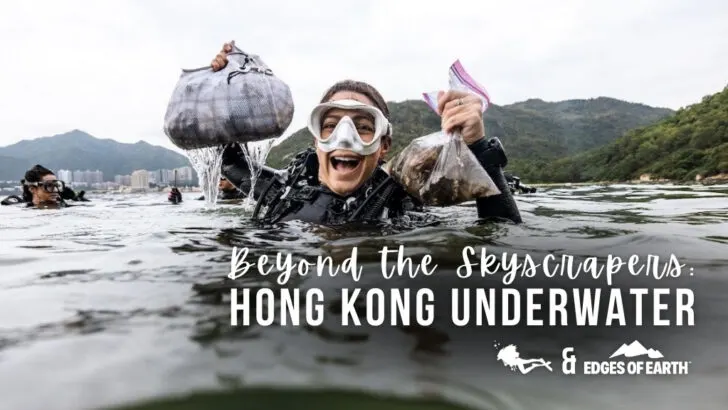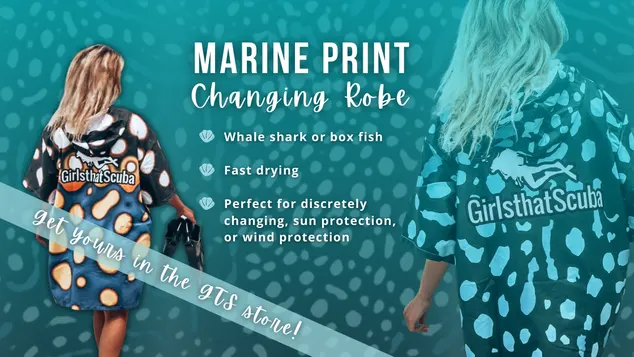This is part of a series of guest posts by Andi Cross, whose incredible expedition is telling dive stories from around the globe. Check out the previous story, and join us as she takes us to the Edges of Earth!
When Hong Kong ended up on our expedition path, we were just as excited as we were surprised. With 7.5 million people living in the city as of mid-year 2022, this destination was extremely different to some of the others we had explored prior. Far from what many would classify as a traditional “edge of earth.”
A Non-Traditional “Edge of Earth”
Upon arriving, we were thrust into a world where the boundaries of exploration and discovery were ever expanding, proving that an “edge of earth” is not just a way to define a geographic location. It’s also a way of thinking. It is the idea that there’s something to discover no matter where you are – from a remote island to one of the most iconic skylines.
It’s about venturing into overlooked spaces and asking questions that defy the ordinary, aiming to unveil unseen worlds that coexist with our familiar landscapes. “Edges of Earth” is where the known and unknown converge.
Joining The Explorers Club Hong Kong Chapter opened a gateway to the city’s less talked about underwater scene – especially when it came to partially intact shellfish reefs. Holding incredible historical and ecological significance, many people who call Hong Kong home hardly know of this hidden treasure that put this trade hotspot on the map eons ago.
A dedicated team of researchers, scientists and conservationists from The Explorers Club, The Nature Conservancy (TNC) and Swire Institute for Marine Sciences of The University of Hong Kong (SWIMS) were behind a project to highlight the importance of shellfish reefs. Once clued into the work that was happening beyond the skyscrapers, we found ourselves re-routing the expedition. We headed to meet with the project lead, Marine Thomas, and her team to dive the Pearl River Delta together.
The Oyster Project
The aim was to conduct an extensive oyster survey in key waters surrounding Hong Kong, in particular Lantau Island. While the global culinary appeal of oysters is widely recognized, their ecological significance remains largely underappreciated. The Oyster Awareness Project was deployed to demystify shellfish reefs, re-establish their value and then help to open eyes on what it will take to restore these critical reefs around the city.
Oysters serve as natural water purifiers. They play a pivotal role in the health of coastal marine ecosystems, all while fostering marine biodiversity. Historically, Hong Kong brimmed with vibrant shellfish reefs which over the centuries, have faced degradation due to, you guessed it, human activities.
They saw a steep decline particularly during the peak of the lime industry era. Lime was a needed resource to fuel rapid urban development, which heavily depended on shellfish shells for calcium carbonate extraction.
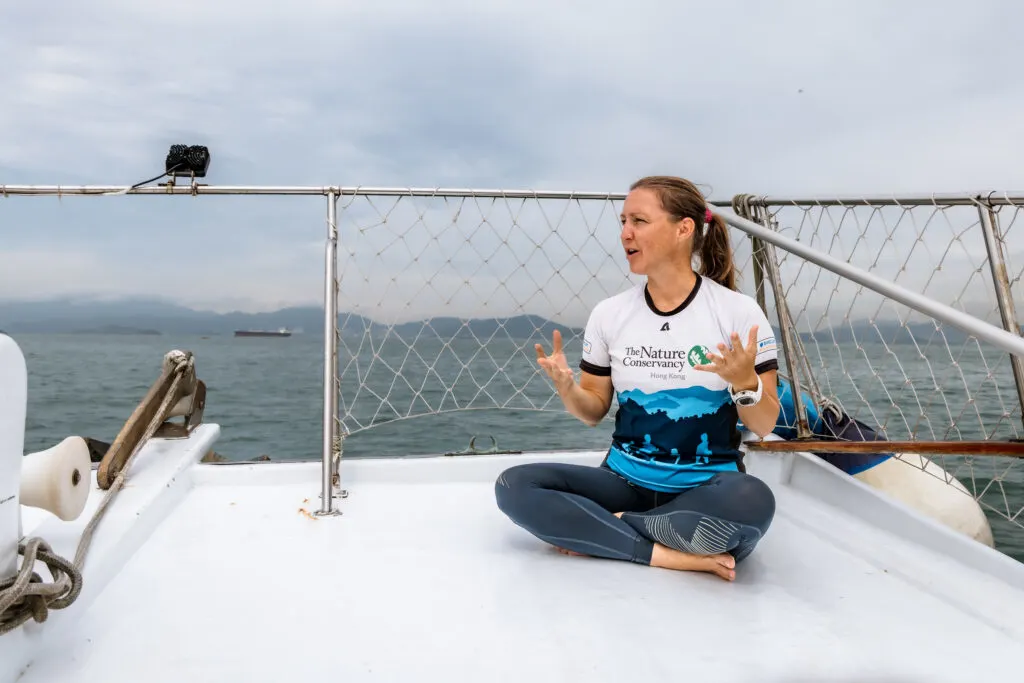
The central motivation behind TNC’s oyster initiative was to shed light on the present state of these valuable marine ecosystems and emphasize the urgent need for their conservation and restoration. Hong Kong’s oyster and shellfish populations, once abundant beyond what we can imagine, have been considerably diminished.
This has impacted both local marine life and the communities dependent on them. The data collected during the project sought to bridge the knowledge gap and re-establish the importance of these reefs, which has long been forgotten.
A Legacy of Data
The overarching vision of the project was not just to document the present state, but to seed a legacy where this extensive data serves as a foundation for future marine conservation and restoration efforts.
The meticulous documentation creates a comprehensive toolkit, paving the way for informed and strategic action. The aim is to regain what critical marine habitats were lost in places where that’s still possible. And at the very least, stop the destruction of whatever is left.
Entering the survey process close to its completion, the results were promising and provided a renewed sense of hope. The surveys all around the Pearl River Delta and nearby islands had revealed patches of reef were still present. This signified the resilience of these habitats and their potential for restoration.
Diving Zero Vis
Conducting the oyster surveys presented unique and challenging conditions for the research team. Equipped with extensive dive gear and the required survey equipment, which they called “The Christmas Tree” (as that’s what it looks like when fully assembled), they embarked on a journey into the murky depths of Hong Kong’s Lantau Island.
The torrential black rain, the heaviest the city had experienced in 140 years, turned the already challenging diving conditions into a formidable task. The reduced visibility, sometimes limited to less than 1 meter (3 feet), necessitated experienced divers with adept maneuvering skills to navigate these conditions.
We’d have to brave both the poor visibility and the unpredictable and aggressive currents that came with the territory. These already difficult conditions were amplified due to relentless rain and heavy boat traffic.
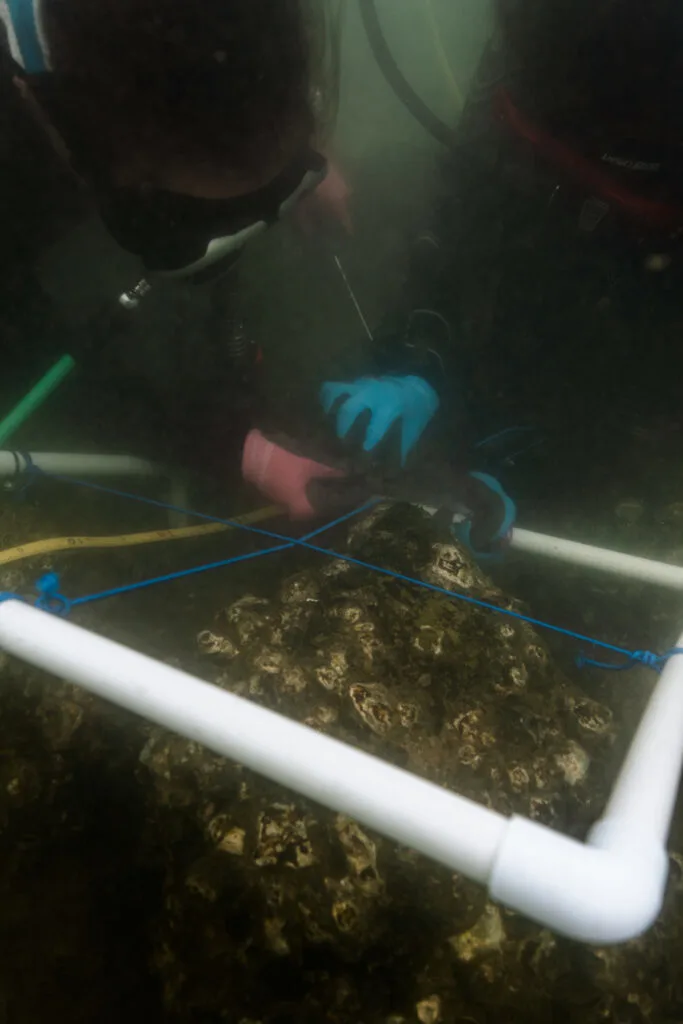
Here, the conditions were always less than ideal. If the team could tolerate it, though, they’d search for oysters, collecting samples varying in shape and size. These samples were critical in painting a comprehensive picture of the current state of the oyster population and the broader health of the region’s waters.
The city’s submerged ecosystems were not only battling the impacts of historical human activities, but were also at the frontline of the unfolding climate crisis. The warm waters and unpredictable weather patterns were a stark, real-time illustration of the environmental challenges at hand. Essentially, with every dive, the project urgency was amplified.
Every oyster found and every sample collected acted as a piece of evidence. This backed up the research team’s hypothesis that there is something worth saving here. Each dive, in the face of adversity, brought the team a step closer to uncovering the resilient narrative of Hong Kong’s underwater world.
The Women in the Muck
Our conversations with Marine and her colleague, Anniqa Chung Kiu Law, another Conservation Project Manager with TNC, opened our eyes to how restoration efforts work. These initiatives, often presumed to be conducted amidst the picturesque backdrops of pristine waters, are in fact painstakingly meticulous and often far from glamorous.
The work requires unwavering dedication and an understanding of what each step in the process ladders up to. Sometimes, in this line of work, it’s hard to see the forest through the trees.
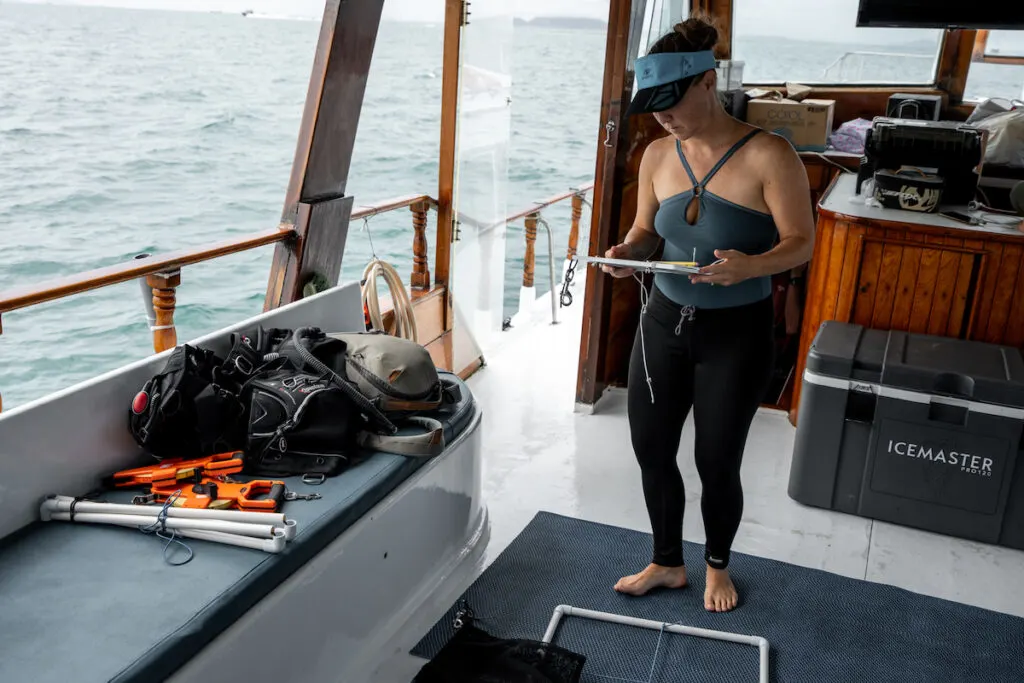
In fact, diving in the muck is very far away from what Marine was doing prior to working with TNC. She transitioned from a career in luxury fashion to marine conservation following a personal awakening – one sparked by a personal loss and an impactful documentary on shark finning.
Leaving behind working with brands like Longchamp and Chanel, she entered the rugged, yet rewarding world of marine ecology. Marine initially joined TNC as an unpaid volunteer. She then obtained her master’s degree in environmental management – all while balancing the responsibilities of first-time motherhood. These experiences ultimately led her to spearhead TNC’s conservation team.
Worlds Apart
Now, she finds fulfillment in the tactile, hands-on restoration of shellfish habitats. A world that couldn’t be more different from the fashion industry, but one that is rich with purpose.
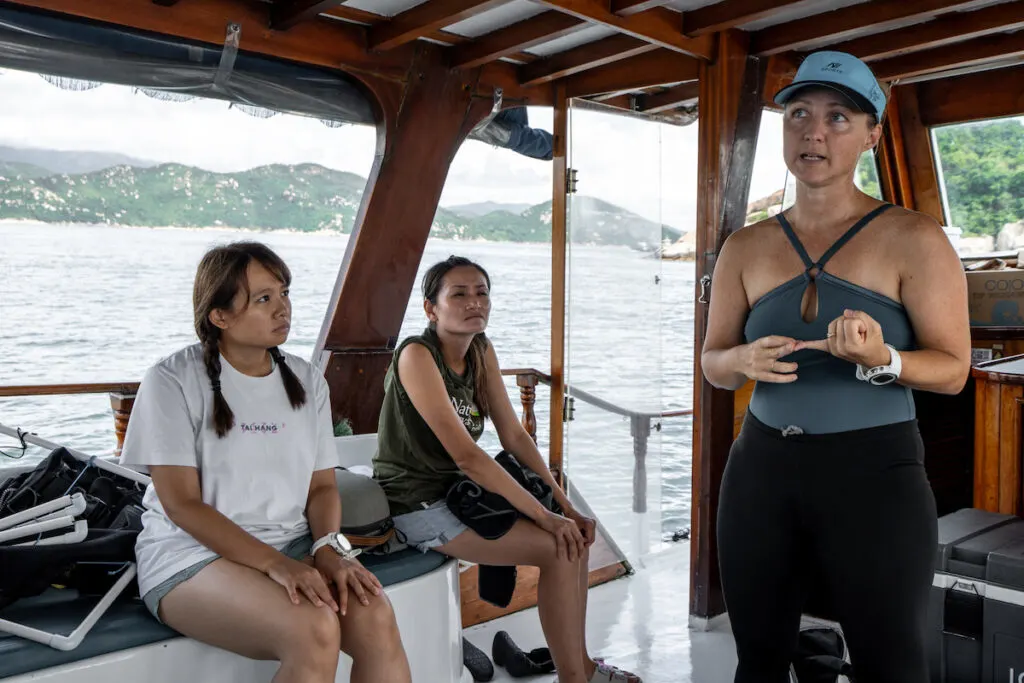
And from Marine’s story a shared narrative emerged. A story woven from the lives of all the women on this research boat who were navigating the confluence of their professional journeys, personal passions and a deeper sense of purpose – from our expedition team to the local dive teams appointed to support the survey.
It was hard not to relate to Marine’s story, as it was not far off from ours or many other women we’ve had the pleasure of meeting while consciously exploring the world.
Each of us found a nexus in our mutual affection for diving and marine life. We felt an immediate closeness. In the communal atmosphere of discovery and exploration, stories of transitions, awakenings and the pursuit of meaningful engagements with our natural world were exchanged.
Inspired by the stories of these women in the field, we continued looking for the last remaining bivalves in Hong Kong. It was very clear that this muddy work meant something and served a greater purpose.
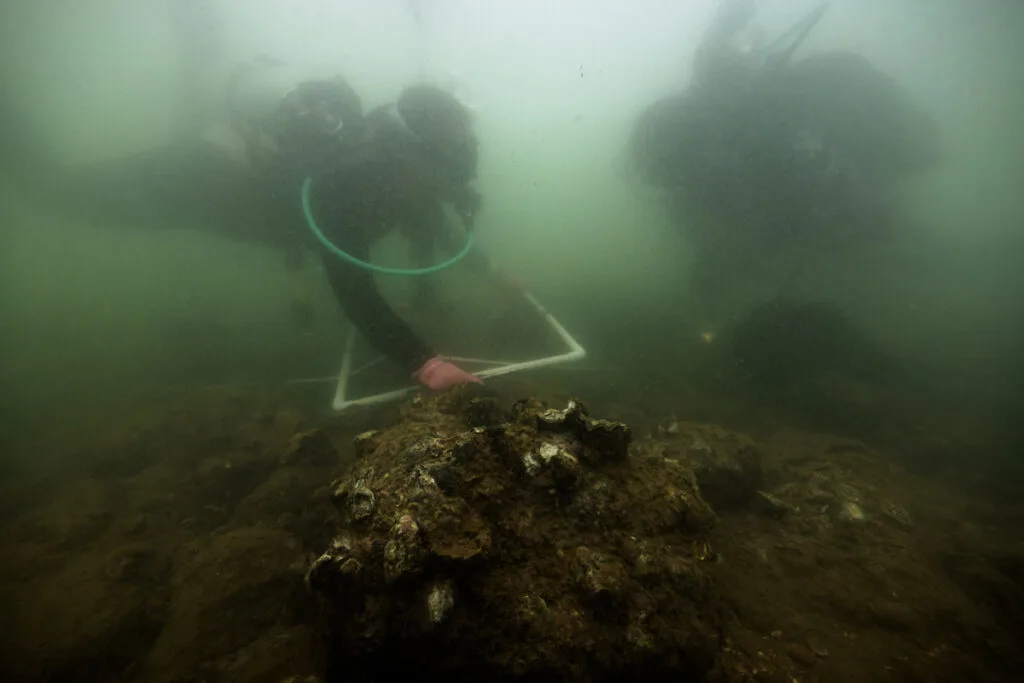
What Comes Next
Every oyster sample collected by Marine, Anniqa, and the local dive teams are more than just a gathering of information. It’s a concrete step towards a deeper understanding of one of the most critical and endangered underwater ecosystems on the planet. The team’s work is grounded in a reality where each discovery contributes to a larger narrative of environmental restoration. It’s a story that often goes untold.
This research conducted won’t just stay within the confines of reports and academic journals. The long-term findings are meant to provide actionable insights that contribute directly to the enhancement of marine conservation efforts. Marine and Anniqa’s work underpins the foundational knowledge required to inform policies, guide restoration projects, while driving future scientific and community engagement.
All Ecosystems Matter
As divers, we are critical stakeholders in the future of our planet. We need to champion the importance of underwater ecosystems that aren’t always considered as critical or necessary. Shellfish reefs are not always top-of-mind for the diving community. It’s up to us to help share why protecting and restoring all marine ecosystems matter, from the coral to the seagrass to the bivalves.
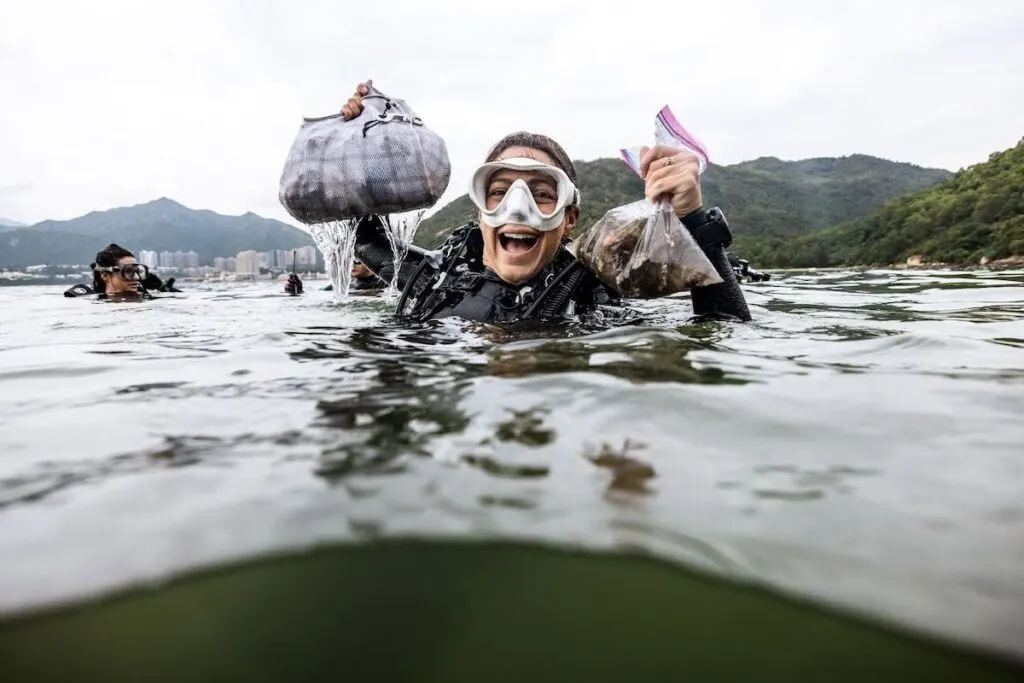
The tireless work of this collective team is a strong call to action. Their studies lay the groundwork, but it’s up to us to advocate for policies that support conservation initiatives, for example. It’s also up to us as divers to expand our interests to some of the more unsuspecting creatures and ecosystems. This will ensure that they are not just meant to be studied, but also meant to be cherished and protected.
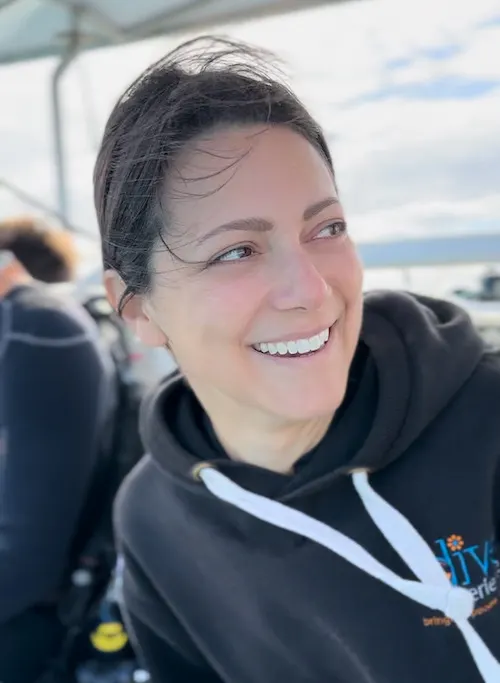
About the Author
Andi Cross is a growth strategist, professional scuba diver and lead of the Edges of Earth expedition, highlighting stories of positive ocean progress and how to explore the world more consciously. To keep up with the expedition, follow the team on Instagram, LinkedIn, TikTok, YouTube and their website.

